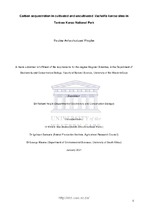| dc.contributor.advisor | Knight, Richard | |
| dc.contributor.author | Phophe, Paulina Avhavhudzani | |
| dc.date.accessioned | 2021-08-16T07:47:03Z | |
| dc.date.available | 2021-08-16T07:47:03Z | |
| dc.date.issued | 2021 | |
| dc.identifier.uri | http://hdl.handle.net/11394/8327 | |
| dc.description | Magister Scientiae (Biodiversity and Conservation Biology) - MSc (Biodiv and Cons Biol) | en_US |
| dc.description.abstract | The Succulent Karoo Biome (SKB) in South Africa is widely reputed to house Earth’s greatest diversity of succulent plants. It is also famous for spectacular displays of annual flowers after good rains. The area experiences winter rainfall which infrequently exceeds 100 mm per annum but certain parts of the SKB can get 250 mm. Irrigated agriculture on a large scale was therefore not a viable option when European farmers began colonizing the land. The land was conquered from the indigenous Khoekhoe herders and San hunter-gatherers, South Africa’s first peoples. The biome underwent extreme transformation in the last 200 years following colonisation which resulted in homogenization of the landscape and extinction of many succulents thus reducing biodiversity. | en_US |
| dc.language.iso | en | en_US |
| dc.publisher | University of Western Cape | en_US |
| dc.subject | Soil properties | en_US |
| dc.subject | Ecoplates | en_US |
| dc.subject | Soil microbes | en_US |
| dc.subject | Carbon storage | en_US |
| dc.subject | Plant allometry | en_US |
| dc.title | Carbon sequestration in cultivated and uncultivated Vachellia karroo sites in Tankwa Karoo National Park | en_US |
| dc.rights.holder | University of Western Cape | en_US |

